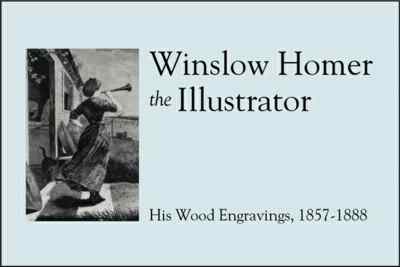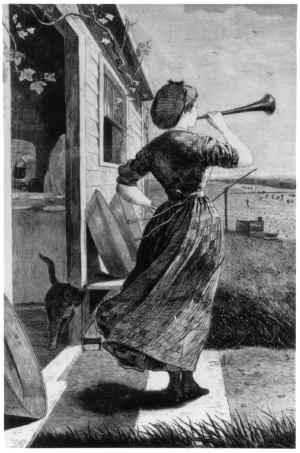 [1]
[1]Editor's note: The Fresno Metropolitan Museum provided source material to Resource Library Magazine for the following article or essay. If you have questions or comments regarding the source material, please contact the Fresno Metropolitan Museum directly through either this phone number or web address:
 [1]
[1]
January 15 - March 13, 2005
The works of one of America's greatest artists will visit Fresno from January 15 through March 13, 2005, as the Fresno Metropolitan Museum hosts Winslow Homer the Illustrator: His Wood Engravings, 1857-1888.
The exhibition, drawn from the collection of the Cornell Fine Arts Museum of Winter Park, Florida, features 145 wood engravings by Homer, exploring his early works as in "Picnicking in the Woods" along with his Civil War engravings and his exploration of middle-class American life in the 1870s and 1880s.
Homer's black and white narratives tell the story of America: first-person glimpses of 19th century life in this country: history, culture, and morals. His engravings are revealing portrayals of American life along the Eastern seaboard -- the seasons, landscapes, the ocean, fishermen, factory workers, children at play, parties, holidays, and Americans abroad.
His early training served him well as he worked within
the limits of a black and white medium better than any artist at the time.
From his  sketchbooks, he would draw
directly onto the surface of planed, end cut hardwood blocks. Engravers
would painstakingly and faithfully incise his lines and crosshatches. The
boxwood blocks were then assembled with text blocks, inked, and printed.
For large circulation magazines, the pressroom's electrotypist, using a
wax mold and copper solution process, created a thin but exact replica of
the surface, which was fitted onto the press. Tens of thousands of exact
copies could be produced in a relatively short time. Throughout his life,
he also worked in oils and watercolor, although his fame as a painter did
not come until later in his life. (right: Winslow Homer: The Dinner
Horn, wood engraving)
sketchbooks, he would draw
directly onto the surface of planed, end cut hardwood blocks. Engravers
would painstakingly and faithfully incise his lines and crosshatches. The
boxwood blocks were then assembled with text blocks, inked, and printed.
For large circulation magazines, the pressroom's electrotypist, using a
wax mold and copper solution process, created a thin but exact replica of
the surface, which was fitted onto the press. Tens of thousands of exact
copies could be produced in a relatively short time. Throughout his life,
he also worked in oils and watercolor, although his fame as a painter did
not come until later in his life. (right: Winslow Homer: The Dinner
Horn, wood engraving)
During the Civil War, Homer was sent to the front as an artist-correspondent for Harper's Weekly, where his war images graphically carried their readers to the battlefield and behind the lines. Fifty are included in the exhibition, including his best known, " The Yankee Sharpshooter." Double-page wood engravings of his illustrations of battles and camp scenes appeared in Harpers throughout the war years. After the war, Harper's Weekly sent him to Europe to chronicle the lives of Americans abroad, which produced some of his most unselfconscious and intimate work.
Perhaps because of his experience covering the horror of Civil War battles, in his later years, Homer chose to portray a gentle, idealized version of the leisure life of Americans, by the sea, in the Adirondacks, and in Europe, untouched by the effects of Reconstruction or the Industrial Revolution. He had a particular talent for portraying children, with an emphasis on the carefree nature of their lives. His 1873 "Snap-the-Whip" may be the most famous depiction ever of American children at play.
Homer is among the few great painters of this country to serve an apprenticeship in lithography, and then go on to become a free-lance illustrator. Winslow Homer's career as illustrator left a lasting legacy and a document of American life that is appreciated more today than even in his time. A strong individual style given to subjects of lasting interest is perhaps the true measure of Winslow Homer's stature as an American illustrator.
This exhibition is on loan from the Cornell Fine Arts Museum in Winter Park, Florida.
About the artist [2]
The United States has produced its own breed of painters true to the vision and character of the nation. In the nineteenth century, one of its greatest was Winslow Homer. Classified as an American naturalist painter, Winslow was a self-taught artist who became most famous for his views of the American landscape and most noteably his seascapes off of the Maine coastline where he lived during the latter part of his life.
Homer was born on February 24, 1836. As a young man, he received his start as an illustrator of magazines. He became a regular contributor of engraving drawings to Harper's Weekly, one of the nation's most popular magazines of the time. After spending a year in Paris in 1856, he returned to the U.S. with a better understanding of the of light in impressionism although he was not really influenced by French art. In the early 1860's, Homer made several trips to the front lines of some Civil War battles in Virginia. It was from sketches he made there that he created his first important oil work, Prisoners from the Front (1866, Metropolitan Museum, New York City).
In 1873, after working in oils for almost twenty years, Homer began also to paint using watercolors. For the rest of his life, this became as important to him as his use of oil and he created many of each. In the mid point of his career, his subjects usually depicted the rural farm scenes of Northeast America, children at play, and fashionable resort views featuring mostly well dressed women.
After living in a fishing village in England in 1881 and 1882, Homer began what was to become the work he was best known for, his seascapes. Once returning to America, he spent most of his remaining winters in Florida, the Bahamas, and Cuba, and the rest of his time in Prout's Neck on the coast of Maine. His basic theme in much of this later work was consistently the struggle between man and nature. One of his most famous masterpieces demonstrating this struggle was Eight Bells (1886, Addison Gallery, Andover, Massachusetts). He died in Prout's Neck in 1910.
Winslow Homer did in showing the beauty of America what many French Impressionists did for Europe, and his body of work will shine as a legacy to our great and beautiful nation.
More from Resource Library:
Multimedia:

Winslow Homer: An American Original is a 49 minute 1999 HBO Artists' Specials series program directed by Graeme Lynch and produced by Devine Entertainment. The artist Winslow Homer has become famous for his illustrations of battle scenes during the Civil War, but he feels disenchanted with what he has experienced and withdraws to a quiet farm. There he meets a pair of teenagers whose lives have been shaken by the war. Together, Homer and the kids learn from each other and move forward with life.

Winslow Homer: The Nature of the Artist is a 29 minute 1986 video directed by Steve York from the National Gallery of Art Series. The art of Winslow Homer is examined in this profile of the American artist, from his early illustrations of the Civil War and his picturesque scenes of the country and shore, to the powerful images of nature that characterize his mature and late work. Commentary by the American art historian John Wilmerding provides a guide to Homer's artistic progress and to his achievements, particularly his transformation of the watercolor medium from the purely descriptive into a highly expressive vehicle.
More resources on the Web for Winslow Homer:
Notes:
1. Graphic courtesy Fresno Metropolitan Museum
2. Biography from www.allaboutartists.com. Copyright © 2004 Internet Marketing Directory
rev. 1/25/05
Read more articles and essays concerning this institutional source by visiting the sub-index page for the Fresno Metropolitan Museum in Resource Library.
Visit the Table of Contents for Resource Library for thousands of articles and essays on American art, calendars, and much more.
Copyright 2005 Traditional Fine Arts Organization, Inc., an Arizona nonprofit corporation. All rights reserved.